sociolinguistics
语言学复习资料
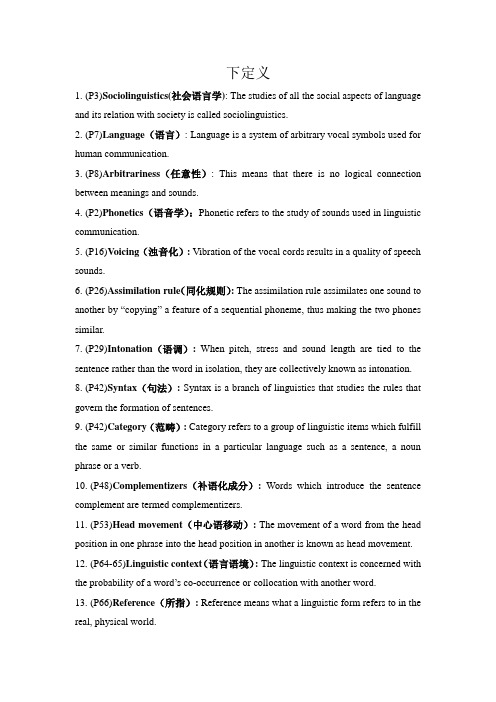
下定义1.(P3)Sociolinguistics(社会语言学): The studies of all the social aspects of language and its relation with society is called sociolinguistics.2.(P7)Language(语言): Language is a system of arbitrary vocal symbols used for human communication.3.(P8)Arbitrariness(任意性): This means that there is no logical connection between meanings and sounds.4.(P2)Phonetics(语音学):Phonetic refers to the study of sounds used in linguistic communication.5.(P16)Voicing(浊音化): Vibration of the vocal cords results in a quality of speech sounds.6.(P26)Assimilation rule(同化规则): The assimilation rule assimilates one sound to another by “copying” a feature of a sequential phoneme, thus making the two phones similar.7.(P29)Intonation(语调): When pitch, stress and sound length are tied to the sentence rather than the word in isolation, they are collectively known as intonation.8.(P42)Syntax(句法): Syntax is a branch of linguistics that studies the rules that govern the formation of sentences.9.(P42)Category(范畴): Category refers to a group of linguistic items which fulfill the same or similar functions in a particular language such as a sentence, a noun phrase or a verb.10.(P48)Complementizers(补语化成分):Words which introduce the sentence complement are termed complementizers.11.(P53)Head movement(中心语移动): The movement of a word from the head position in one phrase into the head position in another is known as head movement.12.(P64-65)Linguistic context(语言语境): The linguistic context is concerned with the probability of a word’s co-occurrence or collocation with another word.13.(P66)Reference(所指): Reference means what a linguistic form refers to in the real, physical world.14.(P70)Relational opposites(关系反义词): Pairs of words that exhibit the reversal of a relationship between the two items are called relational opposites.15.(P74)Argument(论元): An argument is a logical participant in a predication, largely identical with a nominal element in a sentence.16.(P77)Pragmatics(语用学): Pragmatics is the study of how speakers of a language use sentences to effect successful communication.17.(P81)Constatives(表述句): Constatives are statements that either state or describe, and are thus verifiable.填空题第一章1. (P3) If a linguistic aims to describe and analyze the language people actually use, it is said to be descriptive(描写性的). If the linguistic study aims to lay down rules for “correct and standard” behavior in using language, it is said to be prescriptive(规定性的).2.(P4) The description of a language at some point of time in history is a synchronic(共时的)study; the description of a language as it changes through time isa diachronic(历时的)study.3.(P4) Langue(语言)refers to the abstract linguistic system shared by all the members of a speech community, and parole(言语)refers to the realization of language in actual use4. (P5) Chomsky defines competence(语言能力)as the ideal user’s knowledge of the rules of his language, and performance(语言表现)the actual realization of his knowledge in linguistic communication.第二章5.(P17)As some speech sounds produced differ only in some detailed aspects, the IPA provides its users with another set of symbols called diacritics(发音符号/辨音符)6. (P23) A phoneme(音素)is a phonological unit, it is a unit that is of distinctive value, it is an abstract value.7. (P24) It can be easily observed that phonetically similar sounds might be related in two ways. If they are two distinctive phonemes,they are said to form a phonemic contrast(音素对照), e.g. /p/ and /b/ in [pit] and [bit].8. (P24)When two different forms are identical in every way except for one sound segment which occur the same position in the strings, the two sound combinations are said to from a minimal pair(最小配对).e.g pill and bill, pill and till are a minimal pair.9.(P25) Rules that govern the combination of sounds in a particular language, the rules are called sequential rules(序列规则).10.(P27) The phonemic features that occur above the level of the segments are called suprasegmental feature(超音段特征).第三章11.(P33)Morpheme(词素): the smallest unit of language that carries information about meaning or function.A morpheme which can be a word by itself is called a free morpheme(自由词素). Whereas a morpheme that must be attached to another one is called bound morpheme(粘着词素).12.(P33) The variant forms of a morpheme are called its allomorphs(词素变体).第四章13. (P44) Syntactic units that are built around a certain word category are called phrases(短语), the category of which is determined by the word category around which the phrase is built.14. (P45)Phrases that are formed of more than one word usually contain the following elements: head(中心语), specifier(标志语)and complement(补语).15. (P48)The information about a word’s complement is included in the head andtermed subcategorization(次范畴化).16. (P52) Transformation(转换)is a special type of rule that can move an element from one position to another.第五章17. (P67-68)Synonymy:近义关系的分类:1) Dialectal synonyms(方言同义词)-- synonyms used in different regional dialects.(来自不同地域的人使用同一种语言产生的不同)2) Stylistic synonyms(文体同义词) -- synonyms differing in style3) Synonyms that differ in their emotive or evaluative(评价) meaning4) Collocational synonyms(搭配同义)5) Semantically different synonyms(不考)18.(P69) When two words are identical in sound, they are homophones(同音不同形不同义). When two words are identical in spelling, they are homographs(同形不同音不同义). When two words are identical in both sound and spelling, they are complete homonyms(同形同音不同义).19. (P70) Antonymy:反义关系的分类1) Gradable antonyms(可分等级的反义词)2) Complementary antonyms(互补反义词)3) Relational opposites(关系反义词)20.(P72) Componential analysis(成分分析)is a way proposed by the structural semanticists to analyze word meaning. The approach is based upon the belief that the meaning of a word can be dissected into meaning components, called semantic features.第六章21. (P81)Three Speech Acts:三种言语行为According to Austin new model, a speaker might be performing three acts simultaneously when speaking:locutionary act(言内行为), illocutionary act(言外行为), and perlocutionary act(言后行为).22.(P90)Pragmatic failure(语用失误) occurs when the speaker fails to use language effectively to achieve a specific communicative purpose, or when the hearer fails to recognize the intention or the illocutionary(言外之意) force of the speaker’s utterance in the context of communication.第八章23.(P111) Speech variety(言语变体), or language variety, refers to any distinguishable form of speech used by a speaker or a group of speakers.24. (P117) Halliday further distinguishes three social variables(语域三变量)that determine the register: field of discourse(语场), tenor of discourse(语旨), and mode of discourse(语式).25. (P122) The term diglossia(双言制度) refers to a sociolinguistic situation similar to bilingualism where two varieties of a language exist side by side throughout the community, with each having a definite role to play.。
社会语言学名词
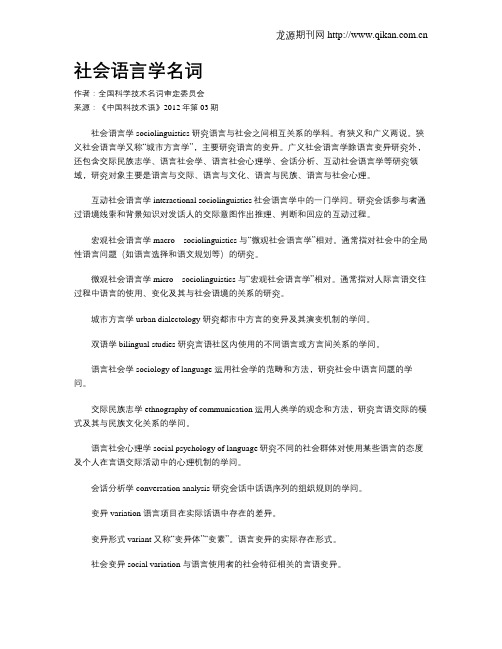
社会语言学名词作者:全国科学技术名词审定委员会来源:《中国科技术语》2012年第03期社会语言学 sociolinguistics 研究语言与社会之间相互关系的学科。
有狭义和广义两说。
狭义社会语言学又称“城市方言学”,主要研究语言的变异。
广义社会语言学除语言变异研究外,还包含交际民族志学、语言社会学、语言社会心理学、会话分析、互动社会语言学等研究领域,研究对象主要是语言与交际、语言与文化、语言与民族、语言与社会心理。
互动社会语言学 interactional sociolinguistics社会语言学中的一门学问。
研究会话参与者通过语境线索和背景知识对发话人的交际意图作出推理、判断和回应的互动过程。
宏观社会语言学 macro sociolinguistics 与“微观社会语言学”相对。
通常指对社会中的全局性语言问题(如语言选择和语文规划等)的研究。
微观社会语言学 micro sociolinguistics 与“宏观社会语言学”相对。
通常指对人际言语交往过程中语言的使用、变化及其与社会语境的关系的研究。
城市方言学 urban dialectology 研究都市中方言的变异及其演变机制的学问。
双语学 bilingual studies 研究言语社区内使用的不同语言或方言间关系的学问。
语言社会学 sociology of language 运用社会学的范畴和方法,研究社会中语言问题的学问。
交际民族志学 ethnography of communication运用人类学的观念和方法,研究言语交际的模式及其与民族文化关系的学问。
语言社会心理学 social psychology of language研究不同的社会群体对使用某些语言的态度及个人在言语交际活动中的心理机制的学问。
会话分析学 conversation analysis 研究会话中话语序列的组织规则的学问。
变异 variation 语言项目在实际话语中存在的差异。
社会语言学练习题及答案(final)
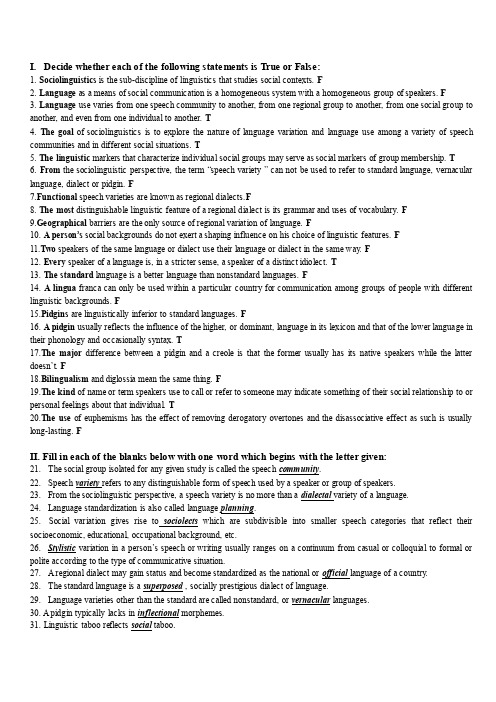
I. Decide whether each of the following statements is True or False:1. Sociolinguistics is the sub-discipline of linguistics that studies social contexts. F2. Language as a means of social communication is a homogeneous system with a homogeneous group of speakers. F3. Language use varies from one speech community to another, from one regional group to another, from one social group to another, and even from one individual to another. T4. The goal of sociolinguistics is to explore the nature of language variation and language use among a variety of speech communities and in different social situations. T5. The linguistic markers that characterize individual social groups may serve as social markers of group membership. T6. From the sociolinguistic per spective, the term “speech variety ” can not be used to refer to standard language, vernacular language, dialect or pidgin. F7.Functional speech varieties are known as regional dialects.F8. The most distinguishable linguistic feature of a regional dialect is its grammar and uses of vocabulary. F9.Geographical barriers are the only source of regional variation of language. F10. A person’s social backgrounds do not exert a shaping influence on his choice of linguistic features. F11.Two speakers of the same language or dialect use their language or dialect in the same way. F12. Every speaker of a language is, in a stricter sense, a speaker of a distinct idiolect. T13. The standard language is a better language than nonstandard languages. F14. A lingua franca can only be used within a particular country for communication among groups of people with different linguistic backgrounds. F15.Pidgins are linguistically inferior to standard languages. F16. A pidgin usually reflects the influence of the higher, or dominant, language in its lexicon and that of the lower language in their phonology and occasionally syntax. T17.The major difference between a pidgin and a creole is that the former usually has its native speakers while the latter doesn’t. F18.Bilingualism and diglossia mean the same thing. F19.The kind of name or term speakers use to call or refer to someone may indicate something of their social relationship to or personal feelings about that individual. T20.The use of euphemisms has the effect of removing derogatory overtones and the disassociative effect as such is usually long-lasting. FII. Fill in each of the blanks below with one word which begins with the letter given:21. The social group isolated for any given study is called the speech community.22. Speech variety refers to any distinguishable form of speech used by a speaker or group of speakers.23. From the sociolinguistic perspective, a speech variety is no more than a dialectal variety of a language.24. Language standardization is also called language planning.25. Social variation gives rise to sociolects which are subdivisible into smaller speech categories that reflect their socioeconomic, educational, occupational background, etc.26. Stylistic variation in a person’s speech or writing usually ranges on a continuum from casual or colloquial to formal or polite according to the type of communicative situation.27. A regional dialect may gain status and become standardized as the national or official language of a country.28. The standard language is a superposed , socially prestigious dialect of language.29. Language varieties other than the standard are called nonstandard, or vernacular languages.30. A pidgin typically lacks in inflectional morphemes.31. Linguistic taboo reflects social taboo.32. The avoidance of using taboo language mirrors social attitudes, emotions and value judgments and has no linguistic basis.III. There are four choices following each statement. Mark the choice that can best complete the statement:33. Sociolinguistics is concerned with the social significance of language variation and language use in different speech communities.34. The most distinguishable linguistic feature of a regional dialect is its accent .35. Regional variation is speech variation according to the particular area where a speaker comes from.36. Geographical barriers are the major source of regional variation of language.37. Language planning means that certain authorities, such as the government choose, a particular speech variety, standardize it and spread the use of it across regional boundaries.38. Stylistic variation in a person’s speech or writing usually ranges on a continuum from casual or colloquial to formal or polite according to the type of communicative situation.39. A lingua franca is a variety of language that serves as a medium of communication among groups of people for diverse linguistic backgrounds .40. Although pidgins are simplified languages with reduced grammatical features, they are rule-governed, like any human language.41. In normal situations, female speakers tend to use more prestigious forms than their male counterparts with the same social background.42. A linguistic taboo refers to a word or expression that is prohibited by the "polite" society from general use.IV. Define the following terms:43. sociolinguisticsSociolinguistics is the study of language in social contexts.44. speech communityThe social group isolated for any given study is called the speech community or a speech community is a group of people who form a community and share the same language or a particular variety of language. The important characteristic of a speech community is that the members of the group must, in some reasonable way, interact linguistically with other members of the community. They may share closely related language varieties, as well as attitudes toward linguistic norms. 45. speech varietySpeech variety, also known as language variety, refers to any distinguishable form of speech used by a speaker or group of speakers. The distinctive characteristics of a speech variety may be lexical, phonological, morphological, syntactic, or a combination of linguistic features.46. language planninglanguage standardization is known as language planning. This means that certain authorities, such as the government or government agency of a country, choose a particular speech variety and spread the use of it, including its pronunciation and spelling systems, across regional boundaries.47. idiolectAn idiolect is a personal dialect of an individual speaker that combines aspects of all the elements regarding regional, social, and stylistic variation, in one form or another. In a narrower sense, what ma kes up one’s idiolect includes also such factors as voice quality, pitch and speech rhythm, which all contribute to the identifying features in an individual' s speech. 48. standard languageThe standard language is a superposed, socially prestigious dialect of language. It is the language employed by thegovernment and the judiciary system, used by the mass media, and taught in educational institutions, in cluding school settings where the language is taught as a foreign or second language.49. nonstandard languageLanguage varieties other than the standard are called nonstandard languages50. lingua francaA lingua franca is a variety of language that serves as a medium of communication among groups of people for diverse linguistic backgrounds.51. pidginA pidgin is a variety of language that is generally used by native speakers of other languages as a medium of communication.52. CreoleA Creole language is originally a pidgin that has become established as a native language in some speech community.53. diglossiaDiglossia usually describes a situation in which two very different varieties of language co-exist in a speech community, each with a distinct range of purely social function and appropriate for certain situations.54. BilingualismBilingualism refers to a linguistic situation in which two standard languages are used either by an individual or by a group of speakers, such as the inhabitants of a particular region or a nation.55. ethnic dialectWithin a society, speech variation may come about because of different ethnic backgrounds . An ethnic language variety is a social dialect of a language, often cutting across regional differences. An ethnic dialect is spoken mainly by a less privileged population that has experienced some form of social isolation, such as racial discrimination or segregation.56. SociolectSocial dialects, or sociolects, are varieties of language used by people belonging to particular social classes.57. registerRegisters are language varieties which are appropriate for use in particular speech situations, in contrast to language varieties that are associated with the social or regional grouping of their customary users. Format reason, registers are als o known as situational dialects.58. slangSlang is a casual use of language that consists of expressive but non-standard vocabulary, typically of arbitrary, flashy and often ephemeral coinages and figures of speech characterized by spontaneity and sometimes by raciness.59. tabootaboo, or rather linguistic taboo, denotes any prohibition by the polite society on the use of particular lexical items to refer to objects or acts.60. euphemismA euphemism, then, is a mild, indirect or less offensive word or expression substituted when the speaker or writer fears more direct wording might be harsh, unpleasantly direct, or offensive.V. Answer the following questions as comprehensively as possible. Give examples for illustration if necessary:61. Discuss with examples that the speech of women may differ from the speech of men.In normal situations, female speakers tend to use more prestigious forms than their male counterparts with the same general social background. For example, standard English forms such as "I did it" and "he isn' t" can be found more often in the speech of females, while the more colloquial "I done it" and "he ain' t" occur more frequently in the speech of males.Another feature often associated with so-called women' s language is politeness. Usually, tough and rough speeches have connotations of masculinity and are not considered to be desirable feminine qualities. In general, men's language is more straightforward, less polite, and more direct, and women's language is more indirect, less blunt, and more circumlocutory. This phenomenon of sex-preferential differentiation is also reflected in the relative frequency with which males and females use the same lexical items. For example, certain words that are closely associated with women may sound typically feminine as a result of that association. For example, some English adjectives like "lovely", "nice", "darling" and "cute" occur more often in female speeches and therefore cause feminine association. Females have also been shown to possess a greater variety of specific color terms than males, in spite of the fact that men do not necessarily possess less acute color perception than women. On the other hand, males have the reputation of possessing a larger vocabulary in traditionally male-dominated domains such as sports, hunting and the military.A request in English such as " Close the door when you leave" can be phrased in a number of ways ranging from a harsh command to a very polite request:a. Close the door when you leave.b. Please close the door when you leave.c. Would you please close the door when you leave?d. Could you close the door when you leave?Although the above options are all available to both men and women, it is usually the more polite forms that are selec ted by female speakers. In general, females are found to use more questions than declarative statements in comparison with males.62. Discuss with examples some of the linguistic differences between Standard English and Black English.One of the most prominent phonological characteristics of Black English is the frequent simplification of consonant clusters at the end of words when one of the two consonants is an alveolar /t/, /d/, /s/, or /z/. The application of this simplification rule may delete the past - tense morpheme, so "past "and "passed "are both pronounced like "pass."Another salient characteristic of Black English phonological system concerns the deletion of some word-final stop consonants in words like "side" and "borrowed." Speakers of Black English frequently delete these word-final stops, pronouncing “side” like “sigh” and “borrowed” like “borrow.”One prominent syntactic feature is the frequent absence of various forms of the copula "be" in Black English, which are required of Standard English. Compare the following expressions in Black English and Standard English:(1) Black English Standard EnglishThey mine. They' re mine.Y ou crazy. Y ou re crazy.Another distinctive syntactic feature of Black English is the systematic use of die expression "it is" where Standard English uses "there is " in the sense of “there exists” :Is it a Mr. Johnson in this office?Another aspect of Black English is the use of double negation constructions. Whenever the verb is negated, the indefinite pronouns "something", "somebody", and "some" become the negative indefinites "nothing", "nobody", and "none", for example:He don't know nothing. (He doesn't know anything.)63. What is a linguistic taboo? What effect does it have on our use of language?A linguistic taboo refers to a word or expression that is prohibited by the "polite" society from general use. Obscene, profane, and swear words are all taboo words that are to be avoided entirely, or at least avoided in mixed company.In sociolinguistics, a linguistic taboo, denotes any prohibition on the use of particular lexical items to refer to objects or acts. As language use is contextualized in particular social settings, linguistic taboo originates from social taboo. When an act is taboo, reference to this act may also become taboo. Taboo words and expressions reflect the particular social customs andviews of a particular culture.As linguistic taboo reflects social taboo, certain words are more likely to be avoided, for examples, the words related to sex, sex organs and excrement in many cultures. The avoidance of using taboo language mirrors social attitudes, emotions and value judgments, and has no linguistic basis.The avoidance of using taboo language has led to the creation of euphemisms. A euphemism is a mild, indirect or less of-fensive word or expression substituted when the speaker or writer fears more direct wording might be hars h, unpleasantly direct, or offensive. For example, we say "portly" instead of "fat".In many cultures, people avoid using direct words that pertain to death or dying because it is the subject that everyone fears and is unpleasant to talk about. In the English-speaking world, for example, people do not “die”, but “pass away”. Euphemisms involve a wide range of fields. Although the use of euphemisms has the effect of removing derogatory overtones, the disassociative effect is never long-lasting. Often when the negative connotation of a word is recognized in its euphemistic form, a new euphemism will have to be sought for. However, an excessive use of euphemism may have negative effects. As a matter of fact, many euphemisms have become cliches that are to be avoided in formal speech and writing. They also tend to be wordy and to give writing a timid quality. In addition, euphemism can be evasive or even deceitful. Because they are often improperly used to obscure the intended meaning, many people find them offensive and prefer plain language.64. 众所周知,所谓"魔力之词",如"thank you"和"please"等,普遍存在。
sociolinguistics
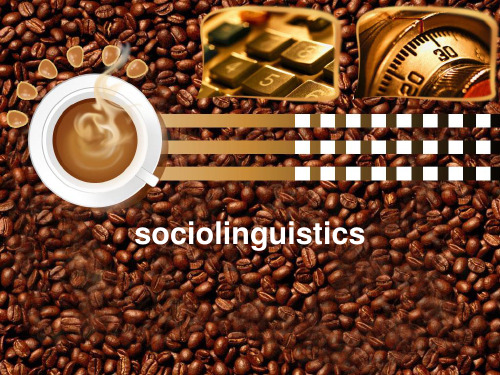
• One of the principal uses of language is to communicate meaning, but it is also used to establish and to maintain social relationships. • It is the second function of language use that sociolinguists study.
• Regional/geographical dialects: • Varieties of a language spoken in a geographical area, such as Cockney dialect, and Yorkshire dialect in Britain, or North Midland dialect and South Midland dialect in the United States, and Guangdong dialect in China.
• Sociolects and standard dialects are often confused because they are interpreted only in terms of prestige. • In due course the sociolect with the highest status in a country often acquires the status of the standard dialect.
• A regional dialect is a variation of language different enough to be classed as a separate entity, but not different enough to be classed as a separate language. • Sometimes a dialect rises in status and becomes the standard variety of a country, becoming standard dialect, e.g. standard English, standard Chinese.
社会语言学简介
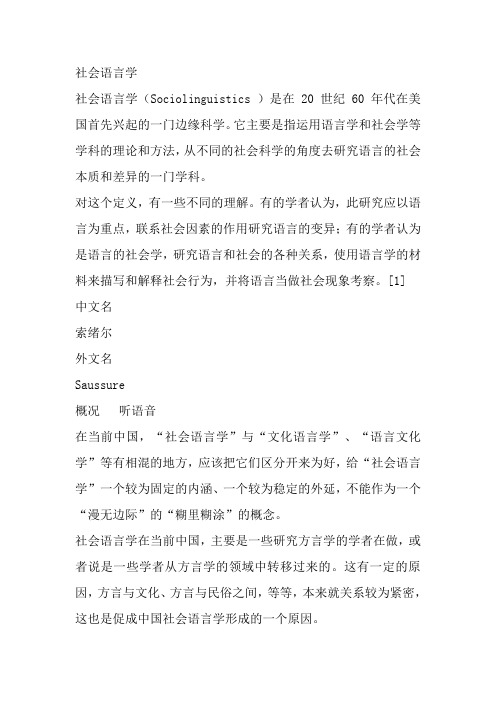
社会语言学社会语言学(Sociolinguistics )是在 20 世纪 60 年代在美国首先兴起的一门边缘科学。
它主要是指运用语言学和社会学等学科的理论和方法,从不同的社会科学的角度去研究语言的社会本质和差异的一门学科。
对这个定义,有一些不同的理解。
有的学者认为,此研究应以语言为重点,联系社会因素的作用研究语言的变异;有的学者认为是语言的社会学,研究语言和社会的各种关系,使用语言学的材料来描写和解释社会行为,并将语言当做社会现象考察。
[1]中文名索绪尔外文名Saussure概况听语音在当前中国,“社会语言学”与“文化语言学”、“语言文化学”等有相混的地方,应该把它们区分开来为好,给“社会语言学”一个较为固定的内涵、一个较为稳定的外延,不能作为一个“漫无边际”的“糊里糊涂”的概念。
社会语言学在当前中国,主要是一些研究方言学的学者在做,或者说是一些学者从方言学的领域中转移过来的。
这有一定的原因,方言与文化、方言与民俗之间,等等,本来就关系较为紧密,这也是促成中国社会语言学形成的一个原因。
社会语言学将从以下两个领域进行探索:第一,是社会生活的变化将引起语言(诸因素)的变化,其中包括社会语境的变化对语言要素的影响。
第二,从语言(诸因素)的变化探究社会(诸因素)的变化。
在第一个领域中,社会是第一性,社会有了变化,才引起语言的变化。
在第二个领域中社会仍是第一性,但未会有像语言相对论者所认为,有什么模式的语言就会产生什么样的社会模式或者社会文化。
社会语言学的任务是在于描述“语言和社会结构的共变”。
“共变”是现代语言学常用的新术语。
该命题说的“共变”是现代语言学常用的新术语。
该命题说的“共变”似乎指语言是一个变数。
这两个变数互相影响,互相作用,互相制约,互相接触而引起的互相变化。
[2]代表人物听语音索绪尔索绪尔(Saussure,1857-1913)首先提出社会语言学的研究方向。
他认为Language分为两个方面:一是语言(Langue)即平时人们研究的语言系统或是总结语言的使用,例如语法,句法,词法等;另一个方面便是言语(Parole),即社会语言学,语言的当代的使用偏好,与当代社会相关联的研究方向。
语言学教程期末考试笔记整理

1. sociolinguistics: as an interdisciplinary study of language use, attempts to show therelationship between language and society. We try to look at structural things by paying attention to language use in a social context and understand sociological things of society by linguistic phenomenon in speaking community.2. pragmatics: is the study of the use of language in communication, particularly therelationships between sentences and the contexts and situations in which they are used.Pragmatics includes the study of3. Psycholinguistics can be defined as the storage, comprehension, production and acquisition oflanguage in any medium (spoken or written). It is concerned primarily with investigating the psychological reality of linguistic structures.4. Cognitive psycholinguistics: Cognitive psycholinguistics is concerned above all with makinginferences about the content of the human mind.5.illocutionary act: it is the act of expressing the speaker’s intention; it is the act performed insaying something.municative competence: refers to what a learners knows about how a language is used inparticular situations for effective and appropriate communication, which include knowledge of the grammar and vocabulary, knowledge of rules of speaking, knowledge of how to use and respond to different types of speech acts and social conventions, and knowledge of how to use language appropriately.7.interlanguage: is often understood as a language system between the target language and thelearner’s native language. It is imperfect with the target language.8. Context of situation(1) The relevant features of the participants: persons, personalities:a. The verbal action of the participantsb. The non-verbal action of the participants(2) The relevant objects(3) The effects of the verbal action9. Speech community: Speech community refers to a group of people who form a community,e.g. a village, a region, a nation, and who have at least one speech variety in common.10. Gender difference: Gender difference is the difference in a speech between men and women.11. Linguistic determinism and linguistic relativity: Linguistic determinism is one of the twopoints in S-W hypothesis, i.e. language determines thought. Linguistic relativity is the other point: there is no limit to the structural diversity of languages.12. What is a speech act?A speech act is an utterance as a functional unit in communication. In speech act theory,utterances have two kinds of meaning.Propositional meaning (locutionary meaning): This is the basic literal meaning of the utterance which is conveyed by the particular words and structures which the utterance contains.Illocutionary meaning (illocutionary force): This is the effect the utterance or written text has on the reader or listener. E.g. in I’m thirsty, the propositional meaning is what the utterance says about the speaker’s physical state. The illocutionary force is the effect the speaker wants the utterance to have on the listener. It may be intended as request for something to drink. A speech act is a sentence or utterance which has both propositional meaning and illocutionaryforce.A speech act which is performed indirectly is sometimes known as an indirect speech act, such as the speech act of the requesting above. Indirect speech acts are often felt to be more polite ways of performing certain kinds of speech act, such as requests and refusals.13. What the Sapir-Whorf hypothesis suggests is like this: our language helps mould our way of thinking and, consequently, different languages may probably express our unique ways of understanding the world. Following this argument, two important points could be captured in the theory. On the one hand, language may determine our thinking patterns; on the other hand, similarity between language is relative, the greater their structural differentiation is, the more diverse their conceptualization of the world will be. For this reason, this hypothesis has alternatively been referred to as linguistic determinism and linguistic relativity. This hypothesis has two versions: a strong and a weak version. The strong version of the theory refers to the claim the original hypothesis suggests, emphasizing the decisive role of language as the shaper of our thinking patterns. The weak version, however, is a modified type of its original theory, suggesting that there is a correlation between language, culture, and thought, but the cross-cultural differences thus produced in our ways of thinking are relative, rather than categorical.14. Locutionary act: A distinction is made by Austin in the theory of speech acts between three different types of acts involved in or caused by the utterance of a sentence.A locutionary act is the saying of something which is meaningful and can be understood. Illocutionary act: An illocutionary act is using a sentence to perform a function. Perlocutionary act: A perlocutionary act is the results or effects that are produced by means of saying something.15. Cooperative principle refers to the “co-operation”between speakers in using the maxims during the conversation. There are four conversational maxims:(1) The maxim of quantity:a. Make your contribution as informative as required.b. Don’t make your contribution more informative than is required.(2) The maxim of quality: Try to make your contribution one that is true.a. Don’t say what you believe to be false.b. Don’t say that for which you lack adequate evidence.(3) The maxim of relation: Say things that are relevant.(4) The maxim of manner: Be perspicuous.a. Avoid obscurity of expression.b. Avoid ambiguity.c. Be brief.d. Be orderly.16. Conversational implicature: The use of conversational maxims to imply meaning during conversation is called conversational implicature.17. Error: Error is the grammatically incorrect form.Mistake: Mistake appears when the language is correct grammatically but improper in a communicational context.18. Input Hypothesis was offered by Krashen. It refers to learner acquire language as a result ofcomprehending input addressed to them. “i+1”principle is most famous.The Input hypothesis is a theory proposed by Krashen (1985) to deal with the relationship between language input and learner s’ acquiring language. According to thishypothesis, learners acquire a language as a result of comprehending input addressed tothem. Krashen brought forward the concept of “i + 1” principle, i.e. the language thatlearners are exposed to should be just far enough beyond their current competence thatthey can understand most of it but still be challenged to make progress. Input shouldneither be so far beyond their reach that they are overwhelmed, nor so close to theircurrent stage that they are not challenged at all.19. Interlanguage is a language system between the target language and the learner’s nativelanguage. It formed when the learner attempts to learn a new language, and it has features of both the first language and the second language but is neither.20. Error: Error is the grammatically incorrect form.21. Mistake: Mistake appears when the language is correct grammatically but improper in acommunicational context.22. Error analysis: Error analysis is the study and analysis of error and is confined to thelanguage learner.。
社会语言学考试资料
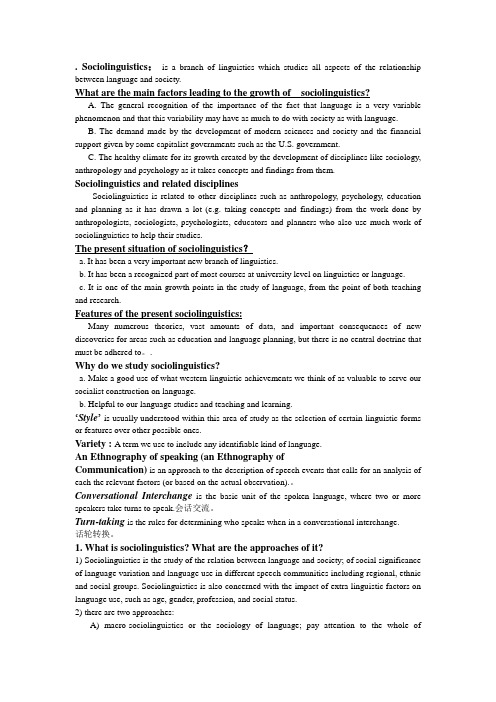
. Sociolinguistics:is a branch of linguistics which studies all aspects of the relationship between language and society.What are the main factors leading to the growth of sociolinguistics?A. The general recognition of the importance of the fact that language is a very variable phenomenon and that this variability may have as much to do with society as with language.B. The demand made by the development of modern sciences and society and the financial support given by some capitalist governments such as the U.S. government.C. The healthy climate for its growth created by the development of disciplines like sociology, anthropology and psychology as it takes concepts and findings from them.Sociolinguistics and related disciplinesSociolinguistics is related to other disciplines such as anthropology, psychology, education and planning as it has drawn a lot (e.g. taking concepts and findings) from the work done by anthropologists, sociologists, psychologists, educators and planners who also use much work of sociolinguistics to help their studies.The present situation of sociolinguistics?a. It has been a very important new branch of linguistics.b. It has been a recognized part of most courses at university level on linguistics or language.c. It is one of the main growth points in the study of language, from the point of both teaching and research.Features of the present sociolinguistics:Many numerous theories, vast amounts of data, and important consequences of new discoveries for areas such as education and language planning, but there is no central doctrine that must be adhered to。
Sociolinguistics
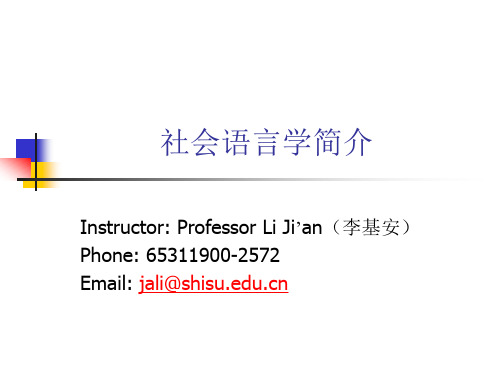
引言
社会语言学是一门年轻的学科,从确立 至今只有 40年左右的历史,但却因其独 特的学科性质和极强的发展能力而备受 关注。 社会语言学的确立以1964年在美国召开 的第9届国际语言学大会为标志。
历史背景
考察语言问题需结合社会因素的思想在 中西学术史中早已有之。 但直到18、19世纪、语言的社会性质才 真正引起人们的重视。有关语言和社会 关系的论述开始出现在一些著名学者的 文章、著作中。
主要流派
社会方言学(social dialectology) 语言社会学(sociology of language) 交际民族志学(ethnopology of communication) 语言社会心理学(social psychology of language) 互动社会语言学(interactional sociolinguistics)
而且成为许多大学语言学系的专业课程, 得到了学术界的普遍承认。
历史背景
就连当初把社会语言学研究比喻为采集蝴蝶标 本的工作,认为其重要性无法同理论语言学相 提并论的乔姆斯基,最后也改变了看法,声称 从不怀疑社会语言学研究在语言科学中的合法 地位。 当代社会语言学的应用研究在法律、广告、诊 断、教育等领域内广泛开展,已经成为社会文 化的有机组成部分之一,引起了越来越多的关 注。
主要流派
互动社会语言学(interactional sociolinguistics)
曾被译为“交际社会语言学”或“相互交往社 会语言学” 会话过程绝不是一个简单的罗列词语的过程。 研究语言和非语言知识在会话过程中的作用以 及说话人的社会文化背景如何跟这些知识相互 影响。
社会语言学论文(基础)Understanding of Sociolinguistics
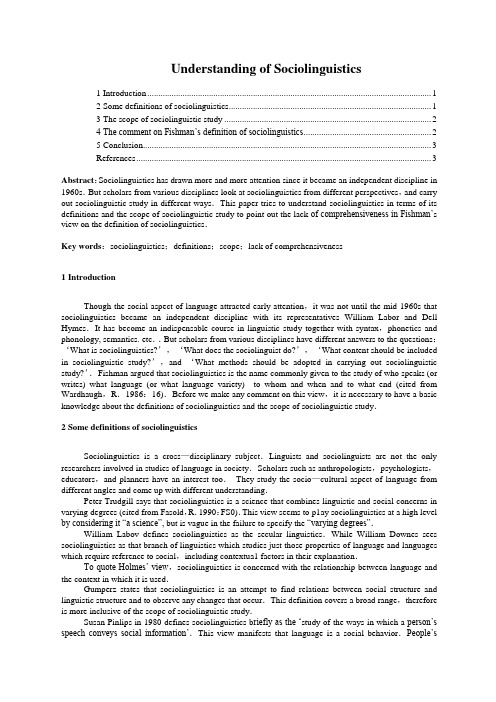
Understanding of Sociolinguistics1 Introduction (1)2 Some definitions of sociolinguistics (1)3 The scope of sociolinguistic study (2)4 The comment on Fishman’s definition of sociolinguistics (2)5 Conclusion (3)References (3)Abstract:Sociolinguistics has drawn more and more attention since it became an independent discipline in 1960s.But scholars from various disciplines look at sociolinguistics from different perspectives,and carry out sociolinguistic study in different ways.This paper tries to understand sociolinguistics in terms of its definitions and the scope of sociolinguistic study to point out the lack of comprehensiveness in Fishman’s view on the definition of sociolinguistics.Key words:sociolinguistics;definitions;scope;lack of comprehensiveness1 IntroductionThough the social aspect of language attracted early attention,it was not until the mid 1960s that sociolinguistics became an independent discipline with its representatives William Labor and Dell Hymes.It has become an indispensable course in linguistic study together with syntax,phonetics and phonology, semantics. etc..But scholars from various disciplines have different answers to the questions:‘What is sociolinguistics?’,‘What does the sociolinguist do?’,‘What content should be included in sociolinguistic study?’,and ‘What methods should be adopted in carrying out sociolinguistic study?’.Fishman argued that sociolinguistics is the name commonly given to the study of who speaks (or writes) what language (or what language variety) to whom and when and to what end (cited from Wardhaugh,R.1986:16).Before we make any comment on this view,it is necessary to have a basic knowledge about the definitions of sociolinguistics and the scope of sociolinguistic study.2 Some definitions of sociolinguisticsSociolinguistics is a cross—disciplinary subject.Linguists and sociolinguists are not the only researchers involved in studies of language in society.Scholars such as anthropologists,psychologists,educators,and planners have an interest too.They study the socio—cultural aspect of language from different angles and come up with different understanding.Peter Trudgill says that sociolinguistics is a science that combines linguistic and social concerns in varying degrees (cited from Fasold,R.1990:FS0).This view seems to p1ay sociolinguistics at a high level by considering it “a science”, but is vague in the failure to specify the “varying degrees”.William Labov defines sociolinguistics as the secular linguistics.While William Downes sees sociolinguistics as that branch of linguistics which studies just those properties of language and languages which require reference to social,including contextua1 factors in their explanation.To quote Holmes’ view,sociolinguistics is concerned with the relationship between language and the context in which it is used.Gumperz states that sociolinguistics is an attempt to find relations between social structure and linguistic structure and to observe any changes that occur.This definition covers a broad range,therefore is more inclusive of the scope of sociolinguistic study.Susan Pinlips in 1980 defines sociolinguistics b riefly as the ‘study of the ways in which a person’s speech conveys social information’.This view manifests that language is a social behavior.People’sdifferent choices of linguistic forms may reflect their different social background.Wolfson expresses his view by saying that sociolinguistics is the study of the interplay of linguistic,social,and cultural factors in human communication.In Longman Dictionary of Language Teaching &Applied Linguistics, sociolinguistics is defined as the study of language in relation to social factors, that is, social class,educational level and type of education, Age, sex,ethnic origins,etc.(Richard,J.C.1992:425).It seems that there is no agreement on the exact definition of sociolinguistics,just like what Dell Hymes has claimed:“Different people may have different understanding of the term ‘sociolinguistics’.Therefore,no one has the patent for its definition.”(cited in Fasold.1990:F 12) But however different views scholars hold,they are ready to agree at least one point.That is,sociolinguistics studies the relation between language and society.Whatever sociolinguistics is,it must be oriented toward both data and theory.But still scholars will come up with different answers to the question ‘What content should be included in sociolinguistic study?’.3 The scope of sociolinguistic studyWe can generally divide sociolinguistic study into the broad sense and the narrow sense.The former is also widely called the macro-sociolinguistics,and the latter micro-sociolinguistics.To make the division clear, Wolfson compared sociolinguistic study to a sort of telescope through which language behavior may be studied in its socio-cultural context.In looking through the small end of the telescope,we view speech at the level of face-to-face interaction,and this type of study is called micro-sociolinguistics.By looking through the large end of the sociolinguistic telescope,we are able to see the workings of language contact,choice,use,maintenance,and change at the social level,a field of study called the sociology of language or macro-sociolinguistics.Hudson in 1980 made a distinction between sociolinguistics and the sociology of language in stating that the former is the study of language in relation to society while the later is the study of society in relation to language(cited in Wardhaugh,R.1986:12-13). That is to say.sociolinguistics can be studied either from the perspective of language or from that of society.Hudson further argues that the influence which society exerts on language is the major concern of sociolinguistic study.Some scholars also classify sociolinguistic study into the theoretical research model and the practical research mode1.But no matter how scholars define and understand sociolinguistics,it is generally agreed that sociolinguistic study mainly deals with social variation, language varieties,the differences of language use conventions,and the socio-cultural factors that contribute to the variation, varieties and differences.Social variation in language including the variation of region,social class, register, style,age and sex has been one of the major focuses of sociolinguistics since its formation in the early 1960.Language variety has been and still is the main concern of sociolinguistics,but the scope of sociolinguistic study may be very wide such that it can cover almost everything.Sociolinguistics is an empirical science.it must be founded on an adequate data base.This requires that when we are considering sociolinguistics,we should take the various kinds of research methods Into account.It is better to collect data through observing naturally occurring linguistic events.The ethnomethodology makes one significant contribution to the development of sociolinguistic study.4 The comment on Fishman’s definition of so ciolinguisticsFishman says that sociolinguistics is the name commonly given to the study of who speaks(or writes)what language (or what language variety)to whom and when and to what end.The American sociolinguist Nessa Wolfson shares the similar view with Fishman in generalizing the scope of sociolinguistics to be‘Who says what to whom,when and how’(cited from Hudson.1980:F14).Brief as Fishman’s definition is,it includes the major elements in sociolinguistics:“what” representsthe language or language variety.“who”, “whom”, “when”and “to what end”represent those social variables.This may be better understood by considering the four components that influence linguistic choices,namely,the participants,the setting or social context of the interaction.the topic and the function(Holmes,Janet.1997:12).Hymes’s SPEAKING theory may also be adopted to account for Fishman’s definition to some extent.In spite of its brevity and reasonableness,this definition is not comprehensive enough to inform us the nature of sociolinguistics,the relationship between it and the sociology of language or other disciplines.Neither does it cover the broad range of the scope of sociolinguistic study.It looks at sociolinguistics from the viewpoint of interpersonal interactions,and covers social variation and language variety, thus belongs to the scope of micro-sociolinguistics.To mention only the language variety does not make the whole story.It also fails to mention the research methods and the theoretical base of sociolinguistic study.Therefore,Fishman’s definition can not provide us with an overall and thorough understanding of sociolinguistics.5 ConclusionThough scholars from various disciplines have shown great interest in the socio—cultural aspect of language,different researchers define sociolinguistics differently and come up with different understanding.In fact,sociolinguistic study is characterized by a wide variety or inclusiveness of its research scope.Cf.McGregor argues that as long as we are fully aware of this point,questions like “How to define sociolinguist ics?” and “What content should be included in sociolinguistic study?” seem to be not very imperative and important(quoted in Fasold,R.1990:F12).References1, Downes, William,1998.Language and Society【M】.2nd edition.Cambridge:CUP.2, Fasold,R.1 990 The Sociolinguistics【M】.Oxford:Blackwell Publishers Ltd.3, Holmes.Janet.I 997.An Introduction to Sociolinguistics【M】.New York:Longman Ltd.4, Hudson,R.A.1 980.Sociolinguistics【M】.2-edition.Cambridge:CUP.5, Richards,C.J.and Platt,J.and Platt,H.1 992.Longman Dictionary of Language Teaching&Applied Linguistics【M】.New York:Longman Ltd.6, Salzmann,Zdenek.1993.Language.Culture.& Social An Introduction to Linguistic Anthropology 【M】.Boulder:Westview Press,Inc.7, Trask,R.L.I999.Key Concepts in Language and Linguistics【M】.London;Routledge.8, Wardhaugh.R.1986.An Introduction to Sociolinguistics:Issues of Society and Schooling 【M】.Oxford:Basil Blackwel1.9, Wardhaugh.R.1998.An Introduction to Sociolinguistics【M】.3 edition.Oxford:Blackwel1.10, Wolfson,N.1989.Perspectives.Sociolinguistics and TESOL【M】.Cambridge:Newbury.。
语言学流派
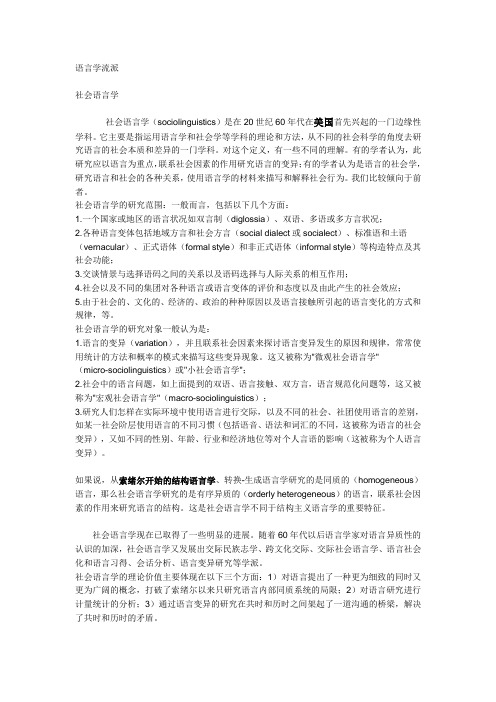
语言学流派社会语言学社会语言学(sociolinguistics)是在20世纪60年代在美国首先兴起的一门边缘性学科。
它主要是指运用语言学和社会学等学科的理论和方法,从不同的社会科学的角度去研究语言的社会本质和差异的一门学科。
对这个定义,有一些不同的理解。
有的学者认为,此研究应以语言为重点,联系社会因素的作用研究语言的变异;有的学者认为是语言的社会学,研究语言和社会的各种关系,使用语言学的材料来描写和解释社会行为。
我们比较倾向于前者。
社会语言学的研究范围:一般而言,包括以下几个方面:1.一个国家或地区的语言状况如双言制(diglossia)、双语、多语或多方言状况;2.各种语言变体包括地域方言和社会方言(social dialect或socialect)、标准语和土语(vernacular)、正式语体(formal style)和非正式语体(informal style)等构造特点及其社会功能;3.交谈情景与选择语码之间的关系以及语码选择与人际关系的相互作用;4.社会以及不同的集团对各种语言或语言变体的评价和态度以及由此产生的社会效应;5.由于社会的、文化的、经济的、政治的种种原因以及语言接触所引起的语言变化的方式和规律,等。
社会语言学的研究对象一般认为是:1.语言的变异(variation),并且联系社会因素来探讨语言变异发生的原因和规律,常常使用统计的方法和概率的模式来描写这些变异现象。
这又被称为"微观社会语言学"(micro-sociolinguistics)或"小社会语言学";2.社会中的语言问题,如上面提到的双语、语言接触、双方言,语言规范化问题等,这又被称为"宏观社会语言学"(macro-sociolinguistics);3.研究人们怎样在实际环境中使用语言进行交际,以及不同的社会、社团使用语言的差别,如某一社会阶层使用语言的不同习惯(包括语音、语法和词汇的不同,这被称为语言的社会变异),又如不同的性别、年龄、行业和经济地位等对个人言语的影响(这被称为个人语言变异)。
Sociolinguistics
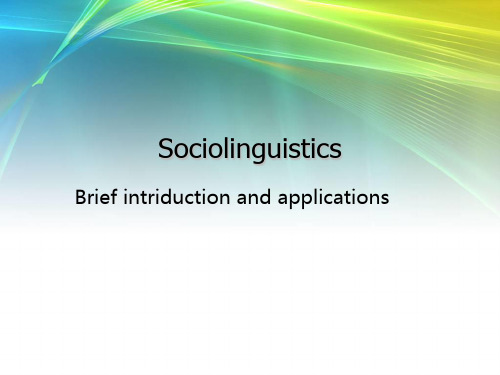
Speech variety
言语变体 Any distinguishable form of speech used by a speaker or a group of speakers. For example, a girl’s way of speaking to her boyfriend is definitely of different styles from the way she speaks to her linguistic professor.
Sociolinguistics
Brief intriduction and applications
What is Sociolinguistics?
DEFINITION: Sociolinguistics is the sub-field of linguistics that studies the relation between language and society. The study of language in relation to social factors. For
• Micro-sociolinguistics
Looking at society from the point of view of an individual member within it.
Concepts in sociolinguistics
Speech community
言语社团
For general linguistics, a speech community is defined as a group of people who form a community and share the same language or a particular variety a language. e.g. a village, a region, a nation, etc.
语言学名词解释

7 root: A root is often seen as part of a word; it can never stand by itself although it bears clear,definite meaning; it must be combined with another root or an affix to form a word.
10 intonation: When pitch, stress and sound length are tied to the sentence rather than the word in isolation, they are collectively known as intonation. Intonation plays an important role in conveying meaning in almost every language,especially in a language like English
2 Phonology: The study of how sounds are put together and used in communication is called phonology.
3 Phone: Phone can be simply defined as the speech sounds we use when speaking a language. A phone is a phonetic unit or segement. It does not necessarily distinguish meaning; some do,some don’t.
社会语言学

游汝杰、邹嘉彦 指出社会语言学(Sociolinguistics)学科名称是由社会学(Sociology)和语言学(Linguistics)复合而成,内容包括两个方面,一是Social Linguistics,基本涵义是:从语言的社会属性出发,用社会学的方法研究语言,从社会的角度解释语言变体和语言演变。二是Sociology of Language,基本涵义是:从语言变体和语言演变的事实,来解释相关的社会现象及其演变和发展的过程。 从研究方向来界定社会语言学,简而言之,前者是从社会研究语言,后者是从语言研究社会。
祝畹瑾
祝畹瑾 她将研究内容细分为五个方面:(1)一个国家或地区的语言状况,和按照各种属性划分的言语共同体使用语言的状况和特征;(2)各种语言变体的构造特点及其社会功能;(3)交谈的情景与选择语码之间的关系以及语码选择与人际关系的相互作用;(4)社会以及不同的集团对各种语言变体的评价和态度以及由此产生的社会效应;(5)由于社会的、文化的、经济的政治的种种原因以及语言接触所引起的语言变化的方式和规律等。 她的界定主要是关注言语共同体、语言变体、语码转换、社会与变体的联系这几个方面。
Sociolinguistics is an umbrella term which covers a variety of different interests in language and society,including the social functions of language and the social characteristics of its users.Sociolinguistics is the studyguage varieties,the characteristics of their functions,and the characteristics of their speakers as these three constantly interact and change within a speechIseeks to discover the societal rules and norms that explain and constrain language behaviour and the behaviour toward language in speech also seeks to determine the symbolic value of language varieties for their speakers.That language varieties come to have symbolic or symptomatic value,in and of themselves,is an inevitable consequence of their functional differentiation.(Reproduction of this article without written permission is strictly prohibited.contact me via email if you want to copy this eassay: This essay is taken from"Linguistics.A Course Book" Editor in chief:胡壮麟Subeditor:姜望琪 资料来源:《语言学教程》 主编:胡壮麟 副主编:姜望琪)
SOCIOLINGUISTICS(1)

Chapter One: Introduction
1.1 What is sociolinguistics? Sociolinguistics is a branch of linguistics which studies all aspects of the relationship between language and society. Sociolinguistics is a relatively new subdiscipline within linguistics which has grown in the past twenty or thirty years. It has been developed on the basis of linguistics, sociology, social psychology, social anthropology and other disciplines. Sociolinguistics is not a mechanical amalgamation of the above disciplines, but a scientific and organic integration of them. It is a marginal discipline as well as an independent one.
Peter Trudgill:
a. the structure of discourse and conversation b. speech acts c. studies in the ethnography of speakers d. investigations of such matters as kinship systems e. studies in the sociology of language, e.g. bilingualism, code-switching, and diglossia f. certain practical concerns such as various aspects of teaching and language behavior in classrooms g. variation theory and linguistic change
socialinguistics.ppt
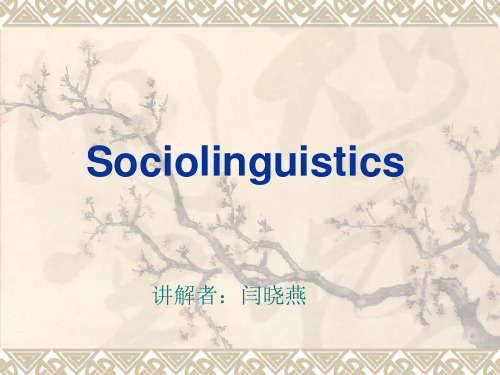
❖If we want to know more about a given society or community by examining the linguistic behaviour of its members, we are doing a sociolinguistic study of society. That is, we are doing sociolinguistics at a macro level of investigation.
The study issues
❖Sociolinguistics deals with subjects such as the linguistic identity of social groups, social attitudes to language, standard and non-standard forms of language, the patterns and needs of national language use, social varieties and levels of language, the social basis of multilingualism, and so on.
Sociolinguistics and Related disciplines
❖parent disciplines: linguistics and sociology
❖related disciplines: anthropology, psychology, gender studies, public policy management, political science and history.
语言学讲义 考研 7 Sociolinguistics
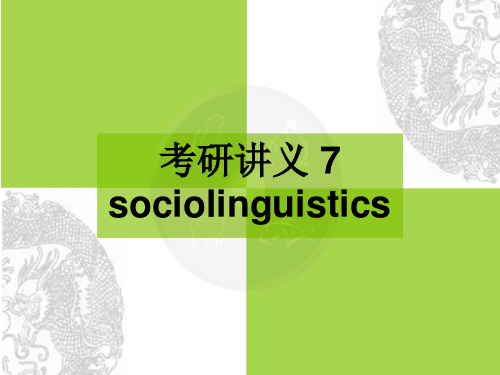
• Users of the same language in a sense all speak differently. What each of them chooses to use is in part determined by one’s social background.
– When we speak we cannot avoid giving our listeners clues about our origin and our background.
– 肥皂剧、卡通、布丁、苹果派、雀巢、巴士、 排挡、耐克、因特网、KTV、EMAIL – Typhoon, gongfu, etc.
15
Netspeak 网络语言
• • • • • • • • • • 顶(支持) 555(呜呜呜) ding(顶) mm/MM(妹妹) LZ(楼主) DD/dd(弟弟) 88(拜拜) 偶(我) 马甲(ID) ID • • • • • • • • • • 斑竹(版主) 恩(嗯) 汗或寒(敬畏) 晕(非常惊异) ps/PS(photoshop的简称) 灌水(发帖子) ddd(顶顶顶) bs/BS(鄙视) 楼猪(楼主) 滴(的、地) 16
9
• Sapir-Whorf Hypothesis
– Edward Sapir (1884 - 1939) and Benjamin Lee Whorf (1897-1941)
• Our language helps mould our way of thinking and, consequently, different languages may probably express speakers’ unique ways of understanding the world.
社会语言学Sociolinguistics(7)
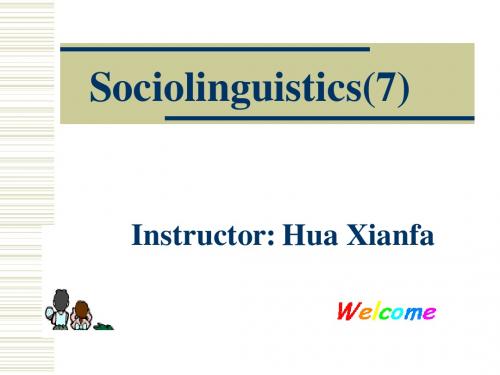
Isogloss and Dialect boundary Isogloss: a line drawn on a map to show the geographical boundaries of the distribution of a particular linguistic feature. Dialect boundary: several isoglosses coincide on the dialect atlas.
Sociolinguistics(7)
Instructor: Hua Xianfa
Chapter V Language and Geography
5.1 Regional Variation Language varies in a number of ways. One way of characterizing certain variations is to say that speakers of a particular language sometimes speak different dialects of that language. As discussed before, dialect is hard to define, but has to be used in studies of regional variation.
Linguistic features of Lingua Franca
a)borrowing words; b)variation in sound system; c)reduced grammar. Social factors have helped the growth and spread of lingua francas.
语言学教程第四版里的名词解释总结(共10篇)
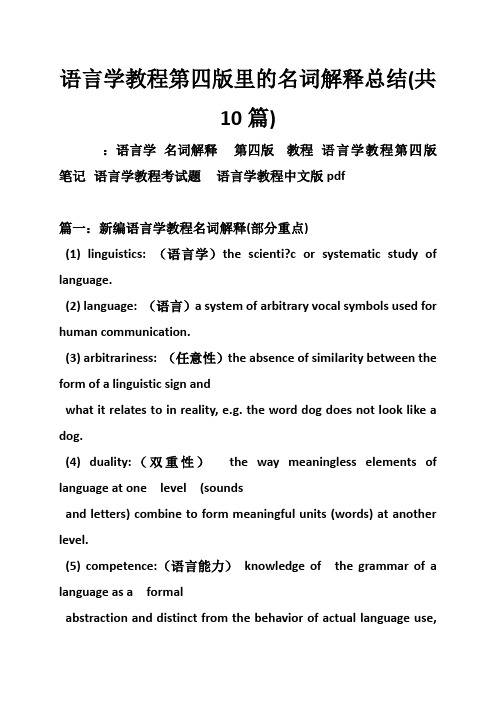
语言学教程第四版里的名词解释总结(共10篇):语言学名词解释第四版教程语言学教程第四版笔记语言学教程考试题语言学教程中文版pdf篇一:新编语言学教程名词解释(部分重点)(1) linguistics: (语言学)the scienti?c or systematic study of language.(2) language: (语言)a system of arbitrary vocal symbols used for human communication.(3) arbitrariness: (任意性)the absence of similarity between the form of a linguistic sign andwhat it relates to in reality, e.g. the word dog does not look like a dog.(4) duality:(双重性)the way meaningless elements of language at one level (soundsand letters) combine to form meaningful units (words) at another level.(5) competence:(语言能力)knowledge of the grammar of a language as a formalabstraction and distinct from the behavior of actual language use,i.e. performance.(6) performance:(语言运用)Chomsky’s term for actual language behavior as distinct from theknowledge that underlies it, or competence.(11) synchronic linguistics: (共时语言学)the study of language and speech as they are used ata given moment and not in terms of how they have evolved over time.(12) diachronic linguistics: (历时语言学)the study of linguistic change over time in contrastto looking at language as it is used at a given moment.(6) phoneme:(音位)the abstract element of a sound, identi?ed as being distinctive in aparticular language.(7) phonetics(语音学): the study of linguistic speech sounds, how they areproduced, how they are perceived, and their physical properties.(8)phonology: (音位学)the study of the abstract systems underlying the sounds of language.(1) morphology:(形态学)the study of the structure of words.(2) morpheme:(词素)the smallest unit of language that carries meaning or serves agrammatical function.(3) free morpheme: (自由词素)a morpheme that can stand alone as a word.(4) bound morpheme: (黏着词素)a morpheme that can not stand alone as a word,e.g. ment (as in establishment), and -er (as in painter).(5) morph:(语素变体)the smallest meaningful phonetic segments of an utterance on the levelof parole.(6) allomorph: a phonetic form in which a morpheme is realized,e.g. -s, -es, and en are allallomorphs (in writing) of the plural morpheme.(1) syntax: the term used to refer to the structure of sentences and to the study of sentencestructure.(句法学)(5) IC analysis:(Immediate constituent analysis 直接成分分析法)the approach to divide thesentence up into its immediate constituents by using binary cutting until obtaining itsultimate constituents.(11) ideational function(概念功能): the use of language as a means of giving structure to ourexperience of the real or imaginary world.(12) interpersonal function(人际功能): the use of language for maintaining social roles andinteracting with others.(13) textual function(语篇功能): to create written or spoken texts which cohere withinthemselves and which ?t the particular situation in which they are used.(1) semantics: the study of linguistic meaning.语义学(14) synonymy:(同义) the sense relations of equivalence of meaning between lexicalitems, e.g. small/little and dead/deceased.(15) antonymy:(反义关系) the sense relation of various kinds of opposing meaning betweenlexical items, e.g. big/small, alive/dead and good/bad.(16) hyponymy:(上下义关系)the sense relation between terms in a hierarchy,where a more particular term (the hyponym) is included in the more general one (thesuperordinate): X is a Y, e.g. a beech is a tree, a tree is a plant. (17) meronym:(整体部分关系)the sense relation between body and its parts which are notonly sections of the body but de?ned in terms of speci?c functions. For example, thehead is the part of the body which carries the most important sense organs, i.e. eyes, ears, nose and tongue.(1) pragmatics:(语用学) a branch of linguistics that studies language in use.(2) deixis:(指示)the marking of the orientation or position of entities and situations withrespect to certain points of reference such as the place (here/there) and time (now/then) of utterance.(1) sociolinguistics: the study of the relationship between language and society, that is, howsocial factors in?uence the structure and use of language.(社会语言学)(8) diglossia:(双语) a situation when two distinct varieties of the same languageare used, side by side, for two different sets of functions.(9) bilingualism:(双语现象)the use of at least two languages either by an individual or by agroup of speakers, such as the inhabitants of a particular region ora nation.(11) taboo:(禁忌)a word or expression that is prohibited by thepolite society from generaluse.(12) euphemism:(委婉语)a word or phrase that replaces a taboo word or is used to avoidreference to certain acts or subjects, e. g. “powder room”for “toilet”.(1) cognitive linguistics: a new approach to the study of language and mind. According to thisapproach, language and language use are based on our bodily experience and the way we conceptualize it.(认知语言学)篇二:]胡壮麟版《语言学教程》前四章名词解释胡壮麟《语言学教程》术语表第一章phonology音系学grammar语法学morphology形态学syntax 句法学lexicology词汇学general linguistics普通语言学theoretical linguistics理论语言学historical linguistics历史语言学descriptive linguistics描写语言学empirical linguistics经验语言学dialectology方言学anthropology人类学stylistics文体学signifier能指signified所指morphs形素morphotactics语素结构学/形态配列学syntactic categories句法范畴syntactic classes句法类别序列sub-structure低层结构super-structure上层结构open syllable开音节closed syllable闭音节checked syllable成阻音节rank 等级level层次ding-dongtheory/nativistic theory本能论sing-song theory唱歌说yo-he-ho theory劳动喊声说pooh-pooh theory感叹说ta-ta theory模仿说animal crytheory/bow-wow theory模声说Prague school布拉格学派Bilateral opposition双边对立Mutilateral opposition多边对立Proportional opposition部分对立Isolated opposition孤立对立Private opposition表缺对立Graded opposition渐次对立Equipollent opposition均等对立Neutralizable opposition可中立对立Constant opposition恒定对立Systemic-functional grammar系统功能语法Meaning potential意义潜势Conversational implicature会话含义Deictics指示词Presupposition预设Speech acts言语行为Discourse analysis话语分析Contetualism语境论Phatic communion寒暄交谈Metalanguage原语言Applied linguistics应用语言学Nominalism唯名学派Psychosomatics身学第二章trachea/windpipe气管tip舌尖blade舌叶/舌面front舌前部center舌中部top舌顶back舌后部dorsum舌背root舌跟pharynx喉/咽腔laryngeals 喉音laryngealization喉化音vocal cords声带vocal tract声腔initiator启动部分pulmonic airstream mechanism肺气流机制glottalic airstream mechanism喉气流机制velaric airstream mechanism腭气流机制Adam’s apple喉结Voiceless sound清音Voiceless consonant请辅音Voiced sound浊音Voiced consonant浊辅音Glottal stop喉塞音Breath state呼吸状态Voice state带音状态Whisper state耳语状态Closed state封闭状态Alveolar ride齿龈隆骨Dorsum舌背Ejective呼气音Glottalised stop喉塞音Impossive内爆破音Click/ingressive吸气音Segmental phonology音段音系学Segmental phonemes音段音位Suprasegmental超音段Non-segmental非音段Plurisegmental复音段Synthetic language综合型语言Diacritic mark附加符号Broad transcription宽式标音Narrow transcription窄式标音Orthoepy正音法Orthography正字法Etymology词源Active articulator积极发音器官Movable speech organ能动发音器官Passive articulator消极发音器官Immovable speech organ不能动发音器官Lateral边音Approximant [j,w]无摩擦延续音Resonant共鸣音Central approximant中央无摩擦延续音Lateral approximant边无摩擦延续音Unilateral consonant单边辅音Bilateral consonant双边辅音Non-lateral非边音Trill [r]颤音trilled consonant颤辅音rolled consonant滚辅音Labal-velar唇化软腭音Interdental齿间音Post-dental后齿音Apico-alveolar舌尖齿龈音Dorso-alveolar舌背齿龈音Palato-alveolar后齿龈音Palato-alveolar腭齿龈音Dorso-palatal舌背腭音Pre-palatal前腭音Post-palatal后腭音Velarization软腭音化Voicing浊音化Devoicing清音化Pure vowel纯元音Diphthong二合元音Triphthong三合元音Diphthongization二合元音化Monophthongization单元音化Centring diphthong央二合元音Closing diphthong闭二合元音Narrow diphthong窄二合元音Wide diphthong宽二合元音Phonetic similarity语音相似性Free variant自由变体Free variation自由变异Contiguous assimilation临近同化Juxtapostional assimilation邻接同化Regressive assimilation逆同化Anticipatoryassimilation先行同化Progressive assimilation顺同化Reciprocal assimilation互相同化Coalescent assimilation融合同化Partial assimilation部分同化Epenthesis插音Primary stress主重音Secondary stress次重音Weak stress弱重音Stress group重音群Sentence stress句子重音Contrastive stress对比重音Lexical stress词汇重音Word stress词重音Lexical tone词汇声调Nuclear tone核心声调Tonetics声调学Intonation contour语调升降曲线Tone units声调单位Intonology语调学Multilevel phonology多层次音系学Monosyllabic word多音节词Polysyllabic word单音节次Maximal onset principle最大节首辅音原则第三章词汇liaison连音contracted form缩写形式frequency count词频统计a unit of vocabulary词汇单位a lexical item词条 a lexeme词位hierarchy层次性lexicogrammar词汇语法morpheme语素nonomorphemic words单语素词polymorphemic words多语素词relativeuninterruptibility相对连续性a minimum free form最小自由形式the maximum free form最大自由形式variable words 可变词invariable words不变词paradigm聚合体grammatical words(function words)语法词/功能词lexical words(content words)词汇词/实义词closed-class words封闭类词opened-class words开放类词word class词类particles小品词pro-form代词形式pro-adjective(so)代形容词pro-verb(do/did)代副词pro-adverb(so)代动词pro-locative(there)代处所词/代方位词determiners限定词predeterminers前置限定词central determiners中置限定词post determiners后置限定词ordinal number序数词cardinal number基数词morpheme词素morphology形态学free morpheme自由词素bound morpheme黏着词素root词根affix词缀stem词干root morpheme词根语素prefix前缀infix中缀suffix后缀bound root morpheme黏着词根词素inflectional affix屈折词缀derivational affix派生词缀inflectional morphemes屈折语素derivational morphemes派生语素word-formation构词compound复合词endocentric compound 向心复合词exocentric compound离心复合词nominal endocentric compound名词性向心复合词adjective endocentric compound形容词性向心复合词verbal compound动词性复合词synthetic compound综合性复合词derivation派生词morpheme 语素phoneme音位morphonology形态语音学morphophomemics形态音位学morphemic structure语素结构phonological structure音素结构monosyllabic单音节polysyllabic多音节phonological conditioned音位的限制morphologicalconditioned形态的限制coinage/invention新创词语blending混成法abbreviation缩写法acronym首字母缩写法back-formation逆序造次/逆构词法analogical creation类比构词法borrowing借词法loanword借词loanblend混合借词loanshift 转移借词loan translation翻译借词loss脱落addition添加metathesis换位assimilation同化contact assimilation接触性同化contiguous assimilation临近性同化theory of least effort省力理论non- contiguous assimilation非临近性同化distant assimilation远距离同化morpho-syntactic change形态-句法变化morphological change形态变化syntactical change句法变化finite element有定成分semantic change语义变化multisemous多种意义broadening词义扩大narrowing词义缩小meaning shift词义转移class shift词性变换folk etymology俗词源orthographic change拼写的变化conversion变换/变码domain范围/领域meaning shift意义转移split infinitives分裂不定式(She was told to regularly classes) calque 仿造词语clipping截断法metanalysis再分化finiteness定式proximate(this)近指代词obviative(that)远指代词non-productivity/unproductive非多产性semiotics符号学paradigmatic relations聚合关系associative relations联想关系syntagmatic relations组合关系sequential relations序列关系logogram语标register语域passive vocabulary消极词汇lexis/vocabulary词汇表第四章句法number数gender性case格nominative主格vocative呼格accusative兵格genitive属格dative与格ablative 离格tense 时aspect体perfective完成体imperfective未完成体concord/agreement一致关系/协同关系government支配关系the governor支配者the governed被支配者signified能指signifier所指syntagmatic relationship组合关系paradigmatic relationship聚合关系associative relationship联想关系animate noun有生名词the two axes两根坐标坐标轴immediate constituent analysis(IC analysis for short)直接成分分析法linear structure线性结构hierarchical structure层级结构construction结构体constituent成分substituability替换性labeled tree diagram标签树形图endocentric/headed construction 向心结构/中心结构exocentric construction离心结构subordinate construction主从结构coordinate construction并列结构recapitulation再现the declarative陈述句the interrogative疑问句dative movement与格移位morph-phonemic rule形态音位规则constituent morphemes成分规则affix hopping词缀越位nominalization名物化object-deletion宾语删除subject-deletion主语删除categories语类lexicon词库temporal subject表时间的主语syntactic limitation句法限制standard theory标准理论trace theory语迹理论the same index带同标志government管辖binding约束a rule system规则系统a principle system原则系统constituentcommand(C-command for short)成分统制plain English普通英语anaphor照应语pronominal指代语r-expression(referential-expression)指称语INFL(inflection)形态变化reciprocals(each other)相互代词accessible subject可及主语local domain局部语域binding domain约束语域logophoricity主人公视角CS(computational system)计算系统Merger合并move移动theme主位rheme述位empty subject空主语objective order客观顺序subjective order主观顺序actual sentence division实义句子切分法functional sentence perspective 功能句子观communicative dynamism (CD)交际动力bipartition二分法tripartite classification三分法representative function表达功能expressive function表情功能appellative/vocative function称呼功能conative function意欲功能poetic function诗学功能ideational function概念功能interpersonal function人际功能textual function语篇功能transitivity及物性actor动作者mood system语气系统the finite verbal operator限定部分residue剩余部分indicative直陈语气imperative祈使语气mental-process(a process of sensing)心理过程(感觉过程)relational process(a process of being)关系过程(属性过程)verbal process(a process of saying)言语过程(讲话过程)existential process生存过程篇三:胡壮麟语言学名词解释总结胡壮麟语言学名词解释总结1. design feature: are features that define our human languages,such asarbitrariness,duality,creativity,displacement,cultural transmission,etc.2. function: the use of language tocommunicate,to think ,nguage functions inclucleimformative function,interpersonal function,performative function, emotive function,phaticcommunion,recreational function and metalingual function.3. etic: a term in contrast with emic which originates from American linguist Pike’s distinction ofphonetics and phonemics.Being etic mans making far too many, as well as behaviouslyinconsequential,differentiations,just as was ofter the case with phonetic vx.phonemic analysisin linguistics proper.4. emic: a term in contrast with etic which originates from American linguist Pike’s distinction ofphonetics and phonemics.An emic set of speech acts and events must be one that is validated as meaningful via final resource to the native members of a speech communith rather than viaqppeal to the investigator’s ingenuith or intuition alone.5. synchronic: a kind of description which takes a fixed instant(usually,but not necessarily,thepresent),as its point of observation.Most grammars are of this kind.6. diachronic:study of a language is carried through the course of its history.7. prescriptive: a kind of linguistic study in which things are prescribed how ought tobe,ying down rules for language use.8. descriptive: a kind of linguistic study in which things are just described.9. arbitrariness: one design feature of human language,which refers to the face that the forms oflinguistic signs bear no natural relationship to their meaning.10. duality: one design feature of human language,which refers to the property of having twolevels of are composed of elements of the secondary.level and each of the two levels has itsown principles of organization.11. displacement: one design feature of human language,which means human language enabletheir users to symbolize objects,events and concepts which are not present c in time andspace,at the moment of communication.12. phatic communion: one function of human language,which refers to the social interaction oflanguage.13. metalanguage: certain kinds of linguistic signs or terms for the analysis and description ofparticular studies.14. macrolinguistics: the interacting study between language and language-related disciplines suchas psychology,sociology,ethnograph,science of law and artificial intelligence etc.Branches ofmacrolinguistics includepsycholinguistics,sociolinguistics,anthropological linguistics,et15. competence: language user’s underlying knowledge about the system of rules.16. performance: the actual use of language in concrete situation.17. langue: the linguistic competence of the speaker.18. parole: the actual phenomena or data of linguistics(utterances).19. Articulatory phonetics: the study of production of speechsounds.20. Coarticulation: a kind of phonetic process in which simultaneous or overlapping articulationsare involved..Coarticulation can be further divided into anticipatory coarticulation andperseverative coarticulation.21. Voicing: pronouncing a sound (usually a vowel or a voiced consonant) by vibrating the vocalcords.22. Broad and narrow transcription: the use of a simple set of symbols in transcription is calledbroad transcription;the use of a simple set of symbols in transcription is called broadtranscription;while,the use of more specific symbols to show morephonetic detail is referred to as narrow transcription.23. Consonant: are sound segments produced by constricting or obstructing the vocal tract at someplace to divert,impede,or completely shut off the flow of air in the oral cavity.24. Phoneme: the abstract element of sound, identified as being distinctive in a particularlanguage.25. Allophone:any of the different forms of a phoneme(eg.this an allophone of /t/inEnglish.When /t/occurs in words like step,it is unaspiratedt.Boththand tare allophones of the phoneme/t/.26. Vowl:are sound segments produced without such obstruction,so no turbulence of a totalstopping of the air can be perceived.27. Manner of articulation: in the production of consonants,manner of articulation refers to theactual relationship between the articulators and thus the way in which the air passes through certain parts of the vocal tract.28. Place of articulation: in the production of consonants,place of articulation refers to where inthe vocal tract there is approximation,narrowing,or theobstruction of air.29. Distinctive features: a term of phonology,i.e.a property which distinguishes one phoneme fromanother.30. Complementary distribution: the relation between tow speech sounds that never occur in thesame environment.Allophones of the same phoneme are usually in complementary distribution.31. IPA: the abbreviation of International Phonetic Alphabet,which is devised by the InternationalPhonetic Association in 1888 then it has undergong a number of revisions.IPA is a comprised system employing symbols of all sources,such as Roman small letters,italics uprighted,obsolete letters,Greek letters,diacritics,etc.32. Suprasegmental:suprasegmental features are those aspects of speech that involve more thansingle sound segments.The principal supra-segmental features are syllable,stress,tone,,and intonation.33. morpheme:the smallest unit of language in terms of relationship between expression andcontent,a unit that cannot be divided into further small units without destroying or drastically altering the meaning,whether it islexical or grammatical.34. compound oly morphemic words which consist wholly of free morphemes,such asclassroom,blackboard,snowwhite,etc.35. inflection: the manifestation of grammatical relationship through the addition of inflectionalaffixes,such as number,person,finiteness,aspect and case,which do not change the grammatical class of the stems to which they are attached.36. affix: the collective term for the type of formative that can be used only when added to anothermorpheme(the root or stem).37. derivation: different from compounds,derivation shows the relation between roots and affixes.38. root: the base from of a word that cannot further be analyzed without total lass of identity.39. allomorph:any of the different form of a morpheme.For example,in English the pluralmortheme is but it is pronounced differently in different environments as/s/in cats,as/z/ in dogs and as/iz/ in classes.So/s/,/z/,and /iz/ are all allomorphs of the plural morpheme.40. Stem: any morpheme or combination of morphemes to which an inflectional affix can beadded.41. bound morpheme: an element of meaning which is structurally dependent on the world it isadded to,e.g. the plural morpheme in “dog’s”.42. free morpheme: an element of meaning which takes the form of an independent word.43. lexeme:A separate unit of meaning,usually in the form of a word(e.g.”dog in the manger”)44. lexicon: a list of all the words in a language assigned to various lexical categories and providedwith semantic interpretation.45. grammatical word: word expressing grammatical meanings,suchconjunction,prepositions,articles and pronouns.46. lexical word: word having lexical meanings,that is ,those which refer to substance,action andquality,such as nouns,verbs,adjectives,and verbs.47. open-class: a word whose membership is in principle infinite or unlimited,such asnouns,verbs,adjectives,and many adverbs.48. blending: a relatively complex form of compounding,in which two words are blended byjoining the initial part of the first word and the final part of the second word,or by joining the initial parts of the two words.49. loanword: a process in which both form and meaning are borrowed with only a slightadaptation,in some cases,to eh phonological system of the new language that they enter.50. loanblend: a process in which part of the form is native and part is borrowed, but the meaningis fully borrowed.51. leanshift: a process in which the meaning is borrowed,but the form is native.52. acronym: is made up form the first letters of the name of an organization,which has a heavilymodified headword.53. loss: the disappearance of the very sound as a morpheme in the phonological system.54. back-formation: an abnormal type of word-formation where a shorter word is derived bydeleting an imagined affix from a long form already in the language.55. assimilation: the change of a sound as a result of the influence of an adjacent sound,which ismore specifically called.”contact”or”contiguous”assimilation.56. dissimilation: the influence exercised.By one sound segment upon the articulation of another,so that the sounds become less alike,or different.57. folk etymology: a change in form of a word or phrase,resulting from an incorrect popularnation of the origin or meaning of the term or from the influence of more familiar terms mistakenly taken to be analogous58. category:parts of speech and function,such as the classification of words in terms of parts ofspeech,the identification of terms of parts of speech,the identification of functions of words in term of subject,predicate,etc.59. prepositional logic: also known as prepositional calculus or sentential calculus,is the study ofthe truth conditions for propositions:how the truth of a composite propositions and theconnection between them.60. Proposition:what is talk about in an utterance,that part of the speech act which has to do withreference.61. predicate logic: also predicate calculus,which studies the internal structure of simple.62. assimilation theory: language(sound,word,syntax,etc)change or process by which features ofone element change to match those of another that precedes or follows.63. cohort theory: theory of the perception of spoken words proposed in the mid-1980s.It saaumesa “recognition lexicon”in which each word is represented by a full andindependent”recognistion element”.When the system receives the beginning of a relevant acoustic signal,all elements matching it are fully acticated,and,as more of the signal isreceived,the system tries to match it independently with each of them,Wherever it fails the element is deactivated;this process continues until only one remains active.64. context effect: this effect help people recognize a word more readily when the receding wordsprovide an appropriate context for it.65. frequency effect: describes the additional ease with which a word is accessed due to its morefrequent usage in language.66. inference in context: any conclusion drawn from a set of proposition,from something someonehas said,and so on.It includes things that,while not following logically,are implied,in anordinary sense,e.g.in a specific context.67. immediate assumption: the reader is supposed to carry out the progresses required tounderstand each word and its relationship to previous words in the sentence as soon as that word in encountered.68. language perception:language awareness of things through the physical senses,esp,sight.69. language comprehension: one of the three strand of psycholinguistic research,which studiesthe understanding of language.70. language production: a goal-directed activety,in the sense that people speak and write in ordeto make friends,influence people,convey information and so on. 71. lexical ambiguity:ambiguity explained by reference to lexical meanings:e.g.that of I saw abat,where a bat might refer to an animal or,among others,stable tennis bat.72. macroproposition:general propositions used to form an overallmacrostructure of the story.73. modular:which a assumes that the mind is structuied into separate modules orcomponents,each governed by its own principles and operating independently of others.74. parsing:the task of assigning words to parts of speech with their appropriateaccidents,traditionally e.g.to pupils learning lat in grammar.75. propositions:whatever is seen as expressed by a sentence which makes a statement.It is aproperty of propositions that they have truth values.76. psycholinguistics: is concerned primarily with investigating the psychological reality oflinguistic structure.Psycholinguistics can be divided into cognitive psycholing uistics(being concerned above all with making inferences about the content of human mind,and experimental psycholinguistics(being concerned somehow whth empirical matters,such as speed of response to a particular word).77. psycholinguistic reality: the reality of grammar,etc.as a purported account of structuresrepresented in the mind of a speaker.Often opposed,in discussion of the merits of alternative grammars,to criteria ofsimplicity,elegance,and internal consistency.78. schemata in text: packets of stored knowledge in language processing.79. story structure: the way in which various parts of story are arranged or organized.80. writing process: a series of actions or events that are part of a writing or continuingdevelopmeng.81. communicative competence: a speaker’s knowledge of the total set ofrules,conventions,erning the skilled use of language in a society.Distinguished byD.Hymes in the late 1960s from Chomsley’s concept of competence,in the restricted sense of knowledge of a grammar. 82. gender difference: a difference in a speech between men and women is”genden difference”83. linguistic determinism: one of the two points in Sapir-Whorf hypothesis,nguagedetermines thought.84. linguistic relativity: one of the two points in Spir-Whorf hypotheis,i.e.there’s no limit to thestructural diversity of languages.85. linguistic sexism:many differences between me and women in language use are brought aboutby nothing less than women’s place in society.86. sociolinguistics of language: one of the two things in sociolinguistics,in which we want tolook at structural things by paying attention to language use in a social context.87. sociolinguistics of society:one of the two things in sociolinguistics,in which we try tounderstand sociological things of society by examining linguistic phenomena of a speaking community.88. variationist linguistics: a branch of linguistics,which studies the relationship betweenspeakers’social starts and phonological variations.89. performative: an utterance by which a speaker does something does something,as apposed to aconstative,by which makes a statement which may be true or false.90. constative: an utterance by which a speaker expresses a proposition which may be true or false.91. locutionary act: the act of saying something;it’s an act of conveying literal meaning by meansof syntax,lexicon,and ly.,the utterance of a。
- 1、下载文档前请自行甄别文档内容的完整性,平台不提供额外的编辑、内容补充、找答案等附加服务。
- 2、"仅部分预览"的文档,不可在线预览部分如存在完整性等问题,可反馈申请退款(可完整预览的文档不适用该条件!)。
- 3、如文档侵犯您的权益,请联系客服反馈,我们会尽快为您处理(人工客服工作时间:9:00-18:30)。
3.2 The Study Scopes of Sociolinguistics
社会语言学的研究范围:一般而言,包括以下几个方面: 1)一个国家或地区的语言状况如双言制(diglossia) 、双语、多语或多方言状况; 2)各种语言变体包括地域方言和社会方言(social dialect或sociolect)、标准语和土语(vernacular) 、正式语体(formal style)和非正式语体(informal style)等构造特点及其社会功能; 3)交谈情景与选择语码之间的关系以及语码选择与人 际关系的相互作用; 4)社会以及不同的集团对各种语言或语言变体的评价 和态度以及由此产生的社会效应; 5)由于社会的、文化的、经济的、政治的种种原因以 及语言接触所引起的语言变化的方式和规律,等等。
empirical investigation.
It is related to methodology and contents of social sciences.
2. DEVELOPMENT AND MAIN REPRESENTATIVES
ORIGINS: Saussure’s & Chomsky’s concepts PROMINENT FIGURES: William Labov & Peter Trudgill
(3). It also studies the influence of the essence and differentiations of society on language (e.g. How to distinguish a person‟s status in his social class by groups, religion, gender, educational level, age, ethnic origin, etc. which he belongs to.) On the whole, sociolinguistics, drawing upon the theories and methods of different aspects of social sciences( such as sociology, anthropology, ethnography, psychology, geography, history, etc.), studies and researches language, and its social essence and differentiations, as well as its social factors.
Prominent Figures United States & United Kindgom
WILLIAM LABOV: regarded as the one who started it with his theories in his empirical works:
The social stratification of English in New York City (1966) Sociolinguistics Patterns (1972)
In 1952, the concept of sociolinguistics has been used first by American linguist H.Currie in his paper: A Projection of Sociolinguistics: the Relationship of Speech to Social Status. Sociolinguistics as an independent discipline was from 1964. at that time, D. Hymes compiled Language in Culture and Society: a Reader in Linguistic and Anthropology. in the same year, W. Bright hosted the first meeting of sociolinguistics.
Sociolinguistics
Contents
1. Definitit and Main Representatives 3. Study Areas and Scopes of Sociolinguistics 4. Sociolinguistics As an Interdiscipline
“Sociolinguistics is the study of language in relation to society.” (Hudson)
Characteristics of Sociolinguistics (Campoy, 1993)
A science, which is concerned with the relationship between
3.STUDY AREAS AND SCOPES OF SOCIOLINGUISTICS
3.1 The study areas of sociolinguistics include: (1). the study of the relations between language and society; (2).the study of characteristics of language varieties, the characteristics of their social functions and the characteristics of their speakers as these three constantly interact and change within a speech community;
• Sociological methodology – with theoretical implications for Linguistics • His study – based on empirical work in social context • Objective – mechanism of linguistic changes & structure of linguistic systems
Chomsky made a distinction between Competence &Performance
Competence refers to the ideal user’s knowledge of the rules of his language. While performance refers to the actual realization of the ideal user’s knowledge of the rules of his language in linguistic communication.
Saussure distinguished the linguistic competence of a speaker and the actual data of utterances as langue and parole. Although parole constitutes the immediately accessible data, the linguist‟s proper object is the langue of each community, the lexicon, grammar, and phonology implanted in each individual by his upbringing in the society.
对社会本质的研究包括: 语言的社会本质的特点及其规律 语言、意识、社会在起源上的相互关系 民族语言和民族形成的关系 民族共同语的形成与社会发展的关系 语言演变与社会演变的关系 对语言差异的研究包括: 标准语[standard languages] 与方言[dialects]、行话 [jargons]的差异;语言变异[language variation]、言语变体 [speech varieties]、语域[registers] ; 洋泾浜语{pidgins]、奥里克 尔语(混合语)[creoles]; 双语现象[diglossia]、双言制 [bilingualism],等等。
“It also studies how language varieties differ between groups separated by certain social variables, e.g., ethnicity, religion, status, gender, level of education, age, etc (...)”.
William Labov
The first one to put into practice the area of sociolinguistics in the United States.
Peter John Trudgill
Later in the United Kingdom
• The British complement for the secular linguistics of Labov. The Social Differentiation of English in Norwich (1971) Sociolinguistic Patterns in British English (1972)
1.DEFINITIONS OF SOCIOLINGUISTICS
Descriptive study – how society influences language “Sociolinguistics is the descriptive study of the effect of any and all aspects of, including cultural, expectations, and context, on the way is used, and the effects of language use on society”. Sociolinguistics is the study of language in relation to society. It studies how social factors influence the structure and use of language.
